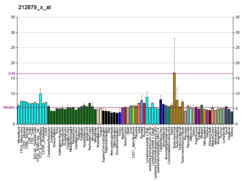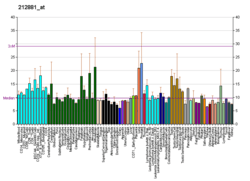PIAS4
E3 SUMO-protein ligase PIAS4 is one of several protein inhibitor of activated STAT (PIAS) proteins. It is also known as protein inhibitor of activated STAT protein gamma (PIASg or PIASy), and is an enzyme that in humans is encoded by the PIAS4 gene.[4][5]
Interactions
PIAS4 has been shown to interact with Mothers against decapentaplegic homolog 6,[6] Mothers against decapentaplegic homolog 7[6] and Lymphoid enhancer-binding factor 1.[7]
gollark: Well, if you're new to programming then probably python.
gollark: Depends what you're intending to do.
gollark: It isn't a good language for applications development because it's wildly unsafe and makes things annoyingly hard.
gollark: In my IMO opinion, you shouldn't learn C unless you're doing embedded/overly low level stuff.
gollark: You can quite easily (ab)use SQLite as a key value database though.
References
- GRCh38: Ensembl release 89: ENSG00000105229 - Ensembl, May 2017
- "Human PubMed Reference:". National Center for Biotechnology Information, U.S. National Library of Medicine.
- "Mouse PubMed Reference:". National Center for Biotechnology Information, U.S. National Library of Medicine.
- Liu B, Liao J, Rao X, Kushner SA, Chung CD, Chang DD, Shuai K (Sep 1998). "Inhibition of Stat1-mediated gene activation by PIAS1". Proc Natl Acad Sci U S A. 95 (18): 10626–31. doi:10.1073/pnas.95.18.10626. PMC 27945. PMID 9724754.
- "Entrez Gene: PIAS4 Protein inhibitor of activated STAT, 4".
- Imoto, Seiyu; Sugiyama Kenji; Muromoto Ryuta; Sato Noriko; Yamamoto Tetsuya; Matsuda Tadashi (Sep 2003). "Regulation of transforming growth factor-beta signaling by protein inhibitor of activated STAT, PIASy through Smad3". J. Biol. Chem. 278 (36): 34253–8. doi:10.1074/jbc.M304961200. ISSN 0021-9258. PMID 12815042.
- Sachdev, S; Bruhn L; Sieber H; Pichler A; Melchior F; Grosschedl R (Dec 2001). "PIASy, a nuclear matrix-associated SUMO E3 ligase, represses LEF1 activity by sequestration into nuclear bodies". Genes Dev. 15 (23): 3088–103. doi:10.1101/gad.944801. ISSN 0890-9369. PMC 312834. PMID 11731474.
Further reading
- Maruyama K, Sugano S (1994). "Oligo-capping: a simple method to replace the cap structure of eukaryotic mRNAs with oligoribonucleotides". Gene. 138 (1–2): 171–4. doi:10.1016/0378-1119(94)90802-8. PMID 8125298.
- Suzuki Y, Yoshitomo-Nakagawa K, Maruyama K, et al. (1997). "Construction and characterization of a full length-enriched and a 5'-end-enriched cDNA library". Gene. 200 (1–2): 149–56. doi:10.1016/S0378-1119(97)00411-3. PMID 9373149.
- Liu B, Gross M, ten Hoeve J, Shuai K (2001). "A transcriptional corepressor of Stat1 with an essential LXXLL signature motif". Proc. Natl. Acad. Sci. U.S.A. 98 (6): 3203–7. doi:10.1073/pnas.051489598. PMC 30631. PMID 11248056.
- Nelson V, Davis GE, Maxwell SA (2001). "A putative protein inhibitor of activated STAT (PIASy) interacts with p53 and inhibits p53-mediated transactivation but not apoptosis". Apoptosis. 6 (3): 221–34. doi:10.1023/A:1011392811628. PMID 11388671.
- Gross M, Liu B, Tan J, et al. (2001). "Distinct effects of PIAS proteins on androgen-mediated gene activation in prostate cancer cells". Oncogene. 20 (29): 3880–7. doi:10.1038/sj.onc.1204489. PMID 11439351.
- Sachdev S, Bruhn L, Sieber H, et al. (2001). "PIASy, a nuclear matrix-associated SUMO E3 ligase, represses LEF1 activity by sequestration into nuclear bodies". Genes Dev. 15 (23): 3088–103. doi:10.1101/gad.944801. PMC 312834. PMID 11731474.
- Ohmine K, Ota J, Ueda M, et al. (2002). "Characterization of stage progression in chronic myeloid leukemia by DNA microarray with purified hematopoietic stem cells". Oncogene. 20 (57): 8249–57. doi:10.1038/sj.onc.1205029. PMID 11781839.
- Tan JA, Hall SH, Hamil KG, et al. (2002). "Protein inhibitors of activated STAT resemble scaffold attachment factors and function as interacting nuclear receptor coregulators". J. Biol. Chem. 277 (19): 16993–7001. doi:10.1074/jbc.M109217200. PMID 11877418.
- Strausberg RL, Feingold EA, Grouse LH, et al. (2003). "Generation and initial analysis of more than 15,000 full-length human and mouse cDNA sequences". Proc. Natl. Acad. Sci. U.S.A. 99 (26): 16899–903. doi:10.1073/pnas.242603899. PMC 139241. PMID 12477932.
- Subramanian L, Benson MD, Iñiguez-Lluhí JA (2003). "A synergy control motif within the attenuator domain of CCAAT/enhancer-binding protein alpha inhibits transcriptional synergy through its PIASy-enhanced modification by SUMO-1 or SUMO-3". J. Biol. Chem. 278 (11): 9134–41. doi:10.1074/jbc.M210440200. PMID 12511558.
- Dahle Ø, Andersen TØ, Nordgård O, et al. (2003). "Transactivation properties of c-Myb are critically dependent on two SUMO-1 acceptor sites that are conjugated in a PIASy enhanced manner". Eur. J. Biochem. 270 (6): 1338–48. doi:10.1046/j.1432-1033.2003.03504.x. PMID 12631292.
- Yamamoto H, Ihara M, Matsuura Y, Kikuchi A (2003). "Sumoylation is involved in beta-catenin-dependent activation of Tcf-4". EMBO J. 22 (9): 2047–59. doi:10.1093/emboj/cdg204. PMC 156076. PMID 12727872.
- Lee PS, Chang C, Liu D, Derynck R (2003). "Sumoylation of Smad4, the common Smad mediator of transforming growth factor-beta family signaling". J. Biol. Chem. 278 (30): 27853–63. doi:10.1074/jbc.M301755200. PMID 12740389.
- Chun TH, Itoh H, Subramanian L, et al. (2003). "Modification of GATA-2 transcriptional activity in endothelial cells by the SUMO E3 ligase PIASy". Circ. Res. 92 (11): 1201–8. doi:10.1161/01.RES.0000076893.70898.36. PMID 12750312.
- Imoto S, Sugiyama K, Muromoto R, et al. (2003). "Regulation of transforming growth factor-beta signaling by protein inhibitor of activated STAT, PIASy through Smad3". J. Biol. Chem. 278 (36): 34253–8. doi:10.1074/jbc.M304961200. PMID 12815042.
- Galleguillos D, Vecchiola A, Fuentealba JA, et al. (2004). "PIASgamma represses the transcriptional activation induced by the nuclear receptor Nurr1". J. Biol. Chem. 279 (3): 2005–11. doi:10.1074/jbc.M308113200. PMID 14559918.
- Gross M, Yang R, Top I, et al. (2004). "PIASy-mediated repression of the androgen receptor is independent of sumoylation". Oncogene. 23 (17): 3059–66. doi:10.1038/sj.onc.1207443. PMID 14981544.
- Zoumpoulidou G, Jones MC, Fernandez de Mattos S, et al. (2005). "Convergence of interferon-gamma and progesterone signaling pathways in human endometrium: role of PIASy (protein inhibitor of activated signal transducer and activator of transcription-y)". Mol. Endocrinol. 18 (8): 1988–99. doi:10.1210/me.2003-0467. PMID 15155784.
- Imoto S, Sugiyama K, Yamamoto T, Matsuda T (2004). "The RING domain of PIASy is involved in the suppression of bone morphogenetic protein-signaling pathway". Biochem. Biophys. Res. Commun. 319 (1): 275–82. doi:10.1016/j.bbrc.2004.04.161. hdl:2115/28116. PMID 15158472.
This article is issued from Wikipedia. The text is licensed under Creative Commons - Attribution - Sharealike. Additional terms may apply for the media files.



